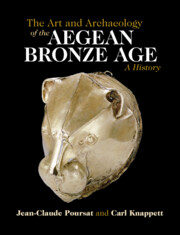Book contents
- The Art and Archaeology of the Aegean Bronze Age
- The Art and Archaeology of the Aegean Bronze Age
- Copyright page
- Contents
- Figures
- Introduction
- Part I Aegean Neolithic Art
- Chapter 1 Artefacts and Contexts
- Chapter 2 Architectural Beginnings
- Chapter 3 Pottery
- Chapter 4 Figurines and Models
- Chapter 5 Other Arts
- Part II The Art of the Aegean Early Bronze Age
- Part III Aegean Art in the Cretan First Palace Period
- Part IV Aegean Art in the Second Palace Period
- Part V Aegean Art in the Cretan Second Palace Period
- Part VI Aegean Art in the Final Palatial Period of Knossos
- Part VII Aegean Art of the Mainland Mycenaean Palatial Period
- Part VIII Aegean Art at the End of the Bronze Age
- Afterword Aegean Art Through Forgers’ Eyes
- References
- Index
- Plate Section (PDF Only)
- References
Chapter 1 - Artefacts and Contexts
from Part I - Aegean Neolithic Art
Published online by Cambridge University Press: 19 May 2022
- The Art and Archaeology of the Aegean Bronze Age
- The Art and Archaeology of the Aegean Bronze Age
- Copyright page
- Contents
- Figures
- Introduction
- Part I Aegean Neolithic Art
- Chapter 1 Artefacts and Contexts
- Chapter 2 Architectural Beginnings
- Chapter 3 Pottery
- Chapter 4 Figurines and Models
- Chapter 5 Other Arts
- Part II The Art of the Aegean Early Bronze Age
- Part III Aegean Art in the Cretan First Palace Period
- Part IV Aegean Art in the Second Palace Period
- Part V Aegean Art in the Cretan Second Palace Period
- Part VI Aegean Art in the Final Palatial Period of Knossos
- Part VII Aegean Art of the Mainland Mycenaean Palatial Period
- Part VIII Aegean Art at the End of the Bronze Age
- Afterword Aegean Art Through Forgers’ Eyes
- References
- Index
- Plate Section (PDF Only)
- References
Summary
The establishment of a sedentary way of life in permanent villages; the beginnings of agriculture (cultivation of cereals and pulses) and animal domestication, which together replace hunting and gathering; and, not long after, the use of pottery: these are the profound changes that mark the shift from the hunter-gatherers of the Mesolithic to Neolithic culture. The Neolithic developed gradually from c.10,000 bc, initially in the ‘Fertile Crescent’ from Mesopotamia to northern Syria, then across the entire Near East. In Europe it established itself first in the Balkans, along the Danube, before reaching the Aegean world around 7000 bc.
The conditions under which this process of ‘Neolithisation’ occurred are still hotly debated. The Neolithic was in all likelihood introduced into Greece by an influx of farmers from the Levant and Anatolia – small groups ended up mixing with local populations, bringing their animals, cereals, and new practices.
- Type
- Chapter
- Information
- The Art and Archaeology of the Aegean Bronze AgeA History, pp. 11 - 14Publisher: Cambridge University PressPrint publication year: 2022



